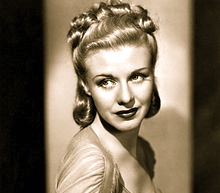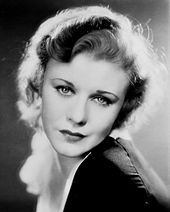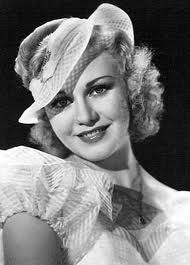Ginger Rogers

Fred and Ginger – Waltz in Swing Time
Fred and Ginger – Waltz in Swing Time
In this Swing Time clip, Lucky, Astaire, saves Penny’s, Rogers, job by showing how much she has taught him. The first true dance number with the two, the other being with Fred fumbling and pretending to be a terrible dancer. Both scenes, however, go to the same song, Pick Yourself Up, this scene without lyrics and much more lively with the other more calm, with lyrics, between the two. Music by Jerome Kern and Lyrics by Dorothy Fields.
(born Virginia Katherine McMath; July 16, 1911 – April 25, 1995) was an American actress, dancer, and singer who appeared in film, and on stage, radio, and television throughout much of the 20th century.
During her long career, she made a total of 73 films, and was best known as Fred Astaire‘s romantic interest and dancing partner in a series of ten Hollywood musical films that revolutionized the genre. She achieved great success on her own in a variety of film roles and won the Academy Award for Best Actress for her performance in Kitty Foyle (1940). She ranks #14 on the AFI’s 100 Years…100 Stars list of actress screen legends.
Early life
Rogers was born Virginia Katherine McMath in Independence, Missouri, the only child of William Eddins McMath, an electrical engineer, and his wife, Lela Emogene (née Owens; 1891–1977). Ginger’s parents separated soon after her birth, and she and her mother went to live with her grandparents, Walter and Saphrona (née Ball) Owens, in nearby Kansas City. Rogers’ parents fought over her custody. After her mother denied him visitation, her father reportedly absconded with his daughter twice. After her parents divorced, Rogers stayed with her grandparents while her mother wrote scripts for two years in Hollywood. Rogers was to remain close to her grandfather (much later, when she was a star in 1939, she bought him a home at 5115 Greenbush Avenue in Sherman Oaks, California so that he could be close to her while she was filming at the studios).
One of Rogers’ young cousins, Helen, had a hard time pronouncing “Virginia”, shortening it to “Ginga”; the nickname stuck. When “Ginga” was nine years old, her mother remarried, to John Logan Rogers. Ginger took the surname Rogers, although she was never legally adopted. They lived in Fort Worth, Texas. Her mother became a theater critic for a local newspaper, the Fort Worth Record. She attended but did not graduate from Fort Worth’s Central High School. As a teenager, Rogers thought of becoming a schoolteacher, but with her mother’s interest in Hollywood and the theater, her early exposure to the theater increased. Waiting for her mother in the wings of the Majestic Theatre, she began to sing and dance along with the performers on stage.
Vaudeville and Broadway
Rogers’ entertainment career was born one night when the traveling vaudeville act of Eddie Foy came to Fort Worth and needed a quick stand-in. She then entered and won a Charleston dance contest which allowed her to tour for six months, at one point in 1926 performing at an 18-month-old theater called The Craterian in Medford, Oregon. This theater honored her many years later by changing its name to the Craterian Ginger Rogers Theater.
At 17, Rogers married Jack Culpepper, a singer/dancer/comedian/recording artist of the day who worked under the name Jack Pepper (according to Ginger’s autobiography, she knew Culpepper when she was a child, as her cousin’s boyfriend). They formed a short-lived vaudeville double act known as “Ginger and Pepper”. The marriage was over within months, and she went back to touring with her mother. When the tour got to New York City, she stayed, getting radio singing jobs and then her Broadway theater debut in a musical called Top Speed, which opened on Christmas Day, 1929.
Within two weeks of opening in Top Speed, Rogers was chosen to star on Broadway in Girl Crazy by George Gershwin and Ira Gershwin, the musical play widely considered to have made stars of both her and Ethel Merman. Fred Astaire was hired to help the dancers with their choreography. Her appearance in Girl Crazy made her an overnight star at the age of 19. In 1930, she was signed by Paramount Pictures to a seven-year contract.
Film career – 1929–1933
 Pre-blonde, early career portrait
Pre-blonde, early career portrait
Rogers’ first movie roles were in a trio of short films made in 1929—Night in the Dormitory, A Day of a Man of Affairs, and Campus Sweethearts.
Rogers would soon get herself out of the Paramount contract—under which she had made five feature films at Astoria Studios in Astoria, Queens—and move with her mother to Hollywood. When she got to California, she signed a three-picture deal with Pathé Exchange. She made feature films for Warner Bros., Monogram, and Fox in 1932 and was named one of fifteen “WAMPAS Baby Stars“. She then made a significant breakthrough as “Anytime Annie” in the Warner Brothers film 42nd Street (1933). She went on to make a series of films with Fox, Warner Bros. (“Gold Diggers of 1933”), Universal, Paramount, and RKO Radio Pictures and, in her second RKO picture, Flying Down to Rio (1933), she worked for the first time with Fred Astaire.



